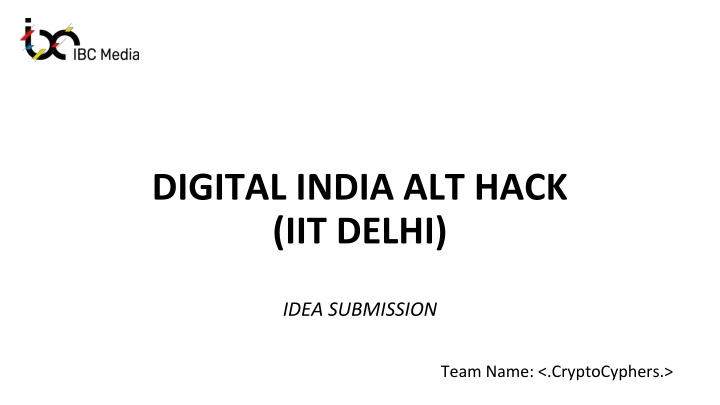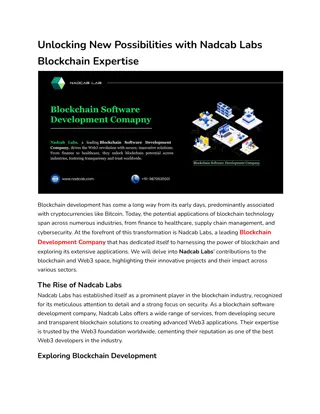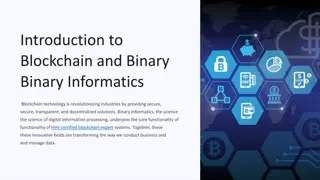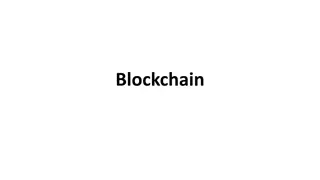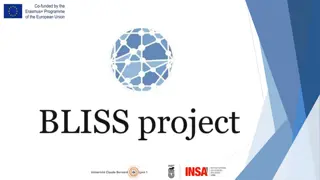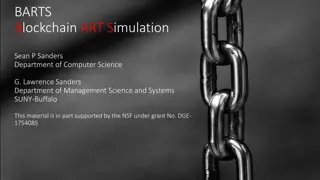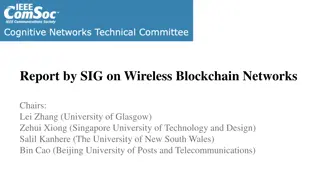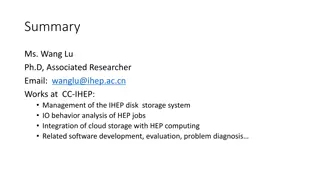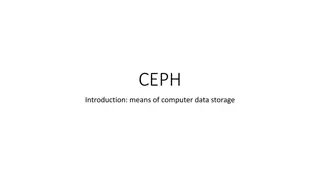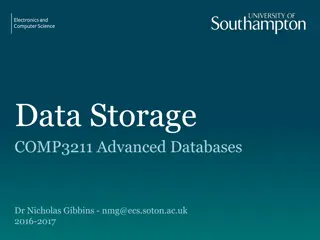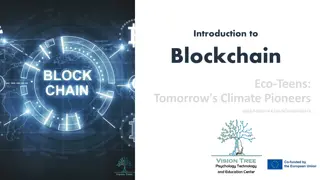Revolutionizing Blockchain Technology for Enhanced Data Processing and Storage
Innovative concepts of relay chains and parachains in blockchain technology, offering increased scalability, security, and interoperability. Discover how implementing these concepts can transform the way transactions and data are handled, leading to a more efficient and transparent digital infrastructure across states and countries."
Download Presentation

Please find below an Image/Link to download the presentation.
The content on the website is provided AS IS for your information and personal use only. It may not be sold, licensed, or shared on other websites without obtaining consent from the author.If you encounter any issues during the download, it is possible that the publisher has removed the file from their server.
You are allowed to download the files provided on this website for personal or commercial use, subject to the condition that they are used lawfully. All files are the property of their respective owners.
The content on the website is provided AS IS for your information and personal use only. It may not be sold, licensed, or shared on other websites without obtaining consent from the author.
E N D
Presentation Transcript
DIGITAL INDIA ALT HACK (IIT DELHI) IDEA SUBMISSION Team Name: <.CryptoCyphers.>
Overview # Topic Slide No. 1 Main Idea 4-6 2 Problem Statement and Prepared solution 7-8 3 Milestones 9
Team Composition # Team member College Specialization Role 1 Chinmay Trikha Guru Tegh Bahadur Polytechnic Institute of Tech Front End Dev. Analyst and Team Host 2 Madhav Tyagi Manav Rachna International Institute of Research and Studies Cybersecurity Technical Head and Mediator 3 Shashank Khanna Guru Tegh Bahadur Polytechnic Institute of Tech Front End Dev. Designing and Implementation
Chosen Track Relay chains and Para chains file system. Parachains and relay chains are innovative concepts in blockchain technology that have the potential to revolutionize the way transactions and data are processed and stored across India. As a decentralized network, these concepts offer increased scalability, security, and interoperability, making them promising solutions for the challenges faced by traditional centralized systems. A parachain is a specialized blockchain that runs in parallel to the main blockchain, known as the relay chain. Each parachain is designed to serve a specific purpose or application, allowing for greater flexibility and efficiency in handling transactions through nodes. By separating different functions into individual parachains, the overall network can handle a higher volume of transactions or store data simultaneously.
The relay chain acts as the central hub that coordinates the parachains. It provides a secure and decentralized infrastructure for communication and consensus among the various parachains. The relay chain ensures the integrity of the network and facilitates interoperability between different parachains(States), allowing them to exchange information and assets like personal information seamlessly. In conclusion, the implementation of parachains and relay chains across India's states has the potential to transform the way transactions and data are processed and stored. By leveraging the benefits of decentralization, scalability, security, and interoperability, these blockchain concepts can contribute to a more efficient, transparent, and inclusive digital infrastructure throughout the states and countries.
Idea Introduction We know how chaining works in WEB3 and PolkaDot network, there is a main chain known as relay chain followed by multiple chains such as Para chains. We also know that Blocks in a chain store data and that data is secure in that network as it is completely decentralised and decentralised network is probably the most secure network out there. Imagine India as a whole being a Relay chain itself followed by 28 Para chains now each Para chain has its own relay chain that connects with the landmass such as wards, sectors, garbs, etc. and then each area is itself is also a relay chain that has nodes in it. Where the nodes are the number of houses in the particular area all connected in a single isolated network. Now we know that each house itself has a Hash address and a state or an area is also having their own hash address, we just solved the problem of doxing attack as the private key is only available to the higher authority of the state or the area. We can just know how many transactions have been made but we cannot find the actual location of that person or place making it harder for any third party to track down an official individual. Documents can be faked but no one can lie to the block chain if it exists then obviously it s on the network. How this Identification system going to work.
Problem statement Centralised system Exposure to cyberattacks Counterfeit document system (Fake Identity, etc)
Why Blockchain Blockchain technology has gained significant attention for its potential to provide a decentralized and secure network in cyberspace. While blockchain technology can offer certain benefits, it is essential to understand its limitations and applicability to specific contexts such as India.
Proposed solution Utilizing a chaining network to decentralize the system and create a user-end only dApp for building a community in India can have several advantages. Here's how it can be beneficial: 1. Decentralization: India, with its vast population and diverse communities, can benefit from decentralized systems. By using a chaining network, the dApp can operate on a peer-to-peer network, removing the need for a centralized authority or intermediary. This empowers users within the community and ensures that no single entity has control over the system, promoting transparency and fairness. 2. User Control and Ownership: With a chaining network-based dApp, users have direct control over their data and actions. They can interact with the blockchain and participate in the decision-making processes within the community. Users maintain ownership of their personal information, reducing concerns about data privacy and security. 3. Community Governance: The dApp can incorporate governance mechanisms that allow community members to participate in decision-making. Through voting mechanisms or consensus protocols, users can collectively determine the direction of the community, propose changes, and vote on important matters. This ensures a more democratic and inclusive environment for community members in India.
4. Trust and Transparency: A chaining network provides a transparent and tamper-resistant record of transactions and activities. This fosters trust among community members as they can independently verify the integrity of the data stored on the blockchain. The decentralized nature of the network also mitigates the risk of single points of failure and enhances the overall security of the system. 5 .Financial Inclusion: India has a large unbanked population, and a user-end only dApp built on a chaining network can facilitate financial inclusion. Through the integration of digital wallets and smart contracts, individuals in India can access financial services, conduct transactions, and participate in economic activities within the community without relying on traditional banking infrastructure. 6.Community Empowerment: A chaining network-based dApp can empower communities in India by providing a platform for collaboration, shared resources, and collective decision-making. It allows individuals to come together, leverage their collective strengths, and address common challenges or pursue common goals. However, it's important to consider the specific needs and challenges of the Indian context, such as infrastructure limitations, digital literacy, and regulatory considerations. Engaging with local communities, understanding their requirements, and designing the dApp accordingly will be crucial for successful adoption and participation. Overall, a chaining network-powered dApp can offer numerous benefits for building a community in India, promoting decentralization, user control, trust, and inclusivity.
Competitive landscape Building a system for India s Government and public security for counterfeit immigrants and this system tracks every movements for the person and has a different approach. This system has also additional features for security and also provide a community for person to interact between peer to peer and creates isolated ecosystem cyberspace in India.
Economics of your solution (Describe the unit economics, scale and the potential revenue generation of your final product) was given in the ppt template, now imagine this network vs the entire population of India all together and maybe the whole world ONE DAY . There is your revenue and scalability.
Milestones and Timeline Duration Milestones Key Action Points ETA- 6 months Successful development of beta project. Successful implementation of the project on small scale.
Milestones Template Team Name CyberCyphers stikONE ( stikaONE) Project Title Members Chinmay Trikha 1 Madhav Tyagi 2 Shashank Khanna 3
Milestones Template Milestone Start Date End Date Duration Remarks High Level Design (HLD) High-level design (HLD) should explain the architecture that would be used to develop the system. The architecture diagram should provide an overview of the entire system, identifying the main components that would be developed for the product and their interfaces. Low Level Design (LLD) The Low-level Design (LLD) should illustrate the low-level logical design of your system. Frontend: The UI architecture Page flow Frontend Framework (Angular, React, Vue, etc.) CSS Framework (Bootstrap, Foundation, Tailwind, etc.) Backend: Smart Contracts that you are going to develop along with their purpose Every function in the contract and what it does
Milestones Template Milestone Start Date End Date Duration Remarks Development Frontend Development Development of your frontend application Backend Development Development of the smart contracts for your application Testing Frontend UI Testing of the frontend web application Backend Unit testing of the smart contract functionality Deployment Frontend Deployment of the frontend web application on web server Backend Deployment of the smart contracts on the testnets
Milestones Template Milestone Start Date End Date Duration Remarks Integration Testing Testing to ensure that the frontend and the backend work together without issues UAT User Acceptance Testing Final Deployment Deployment of the final application (web server for frontend, and mainnet for the smart contracts
Solution Impact Impact nature Impact description Impact on income Paisa hi paisa imagine DOT vs the entire population of India and there is an unlimited possibility as the chain will keep on increasing too. Impact on living standard Everything is digital and the data is only stored within the user s Para chain network Impact on sustainability The chain goes on forever Any other impact Security with better techniques and solution of one being
Summary The concept of chaining, such as Para chains, The Polkadot network enables the secure storage of data in a decentralized manner. Each Para chain has its own relay chain connecting to landmasses. The hash address of each house in a state or area is linked to the house owner. This identification system solves the time process problem, as it allows for the identification of one person's address linked to the house owner. Polkadot provides this chaining feature, making it more secure and faster than ever. With just a few clicks, users can access their data using their public key, reducing the time and effort required for traditional documents file system. This approach can be applied to security checks, such as education and police check posts, where access to vital information is crucial. In conclusion, the use of multiple chains, such as Para chains, in the Polkadot network enables the secure storage of data and improved security measures.
THANK YOU <cryptocypherssmc@gmail.com>
